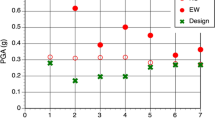Abstract
Seismic hazard maps are constructed by extrapolating from the frequency of small earthquakes, the annual probability of large, infrequent, earthquakes. Combining the potential contribution from all seismically active volumes, one calculates the peak ground acceleration with a probability to be exceeded by 10 % in 50 years at any given point. The consequential risk, the losses to be expected, derives from the damage the calculated shaking causes to buildings, and the impact on occupants due to collapsing structures. We show that the numbers of fatalities in recent disastrous earthquakes were underestimated by the world seismic hazard maps by approximately two to three orders of magnitude. Thus, seismic hazard maps based on the standard method cannot be used to estimate the risk to which the population is exposed due to large earthquakes.

Similar content being viewed by others
References
Aptikaev F, Mokrushina N, Erteleva O (2008) The Mercalli family of seismic intensity scales. Vulkanol i Seismol 3:74–78 (in Russian)
Castanos H, Lomnitz C (2002) PSHA: is it science? Eng Geol 66:315–317
Cornell CH (1968) Engineering seismic risk analysis. Bull Seismol Soc Am 58:1583–1606
Cryanoski D (2011) Japan faces up to failure of its earthquake preparations. Systems for forecasting, early warning and tsunami protection all fell short on 11 March. Nature 471:556–557
Geller RJ (2011) Shake-up time for Japanese seismology. Nature 472:407–409
Giardini D (1999) The global seismic hazard assessment program (GSHAP)—1992/1999. Ann Geophys 42:957–974
Gutenberg R, Richter CF (1944) Frequency of earthquakes in California. Bull Seismol Soc Am 34:185–188
Gutenberg B, Richter CF (1954) Magnitude and energy of earthquakes. Ann Geophys 9:1–15
Klügel JU (2007) Error inflation in probabilistic seismic hazard analysis. Eng Geol 90:186–192
Klügel JU (2011) Uncertainty analysis and expert judgment in seismic hazard analysis. Pure Appl Geophys 168(1–2):27–53
Kossobokov VG, Nekrasova AK (2011) Global seismic hazard assessment program (GSHAP) maps are misleading. Probl Eng Seismol 38(1):65–76 (in Russian)
Murphy JR, O’Brien LJ (1977) The correlation of peak ground acceleration amplitude with seismic intensity and other physical parameters. Bull Seismol Soc Am 67:877–915
Panza GF, Irikura K, Kouteva-Guentcheva M, Peresan A, Wang Z, Saragoni R (eds) (2011) Advanced seismic hazard assessment, vol 168, 1st edn. Springer, Basel, p 752
Paskaleva I, Kouteva-Guencheva M, Vaccari F, Panza GF (2011) Some contributions of the neo-deterministic seismic hazard assessment approach to earthquake risk assessment for the city of Sofia. Pure Appl Geophys 168:521–541
Peresan A, Zuccolo E, Vaccari F, Gorshkov A, Panza GF (2011) Neo-deterministic seismic hazard and pattern recognition techniques: time dependent scenarios for north-eastern Italy. Pure Appl Geophys 168:583–607
Sauter F, Shah HC (1978) Estudio de seguro contra terremoto, 1st edn. Franz Sauter y Asociados Ltda., San Jose, Costa Rica, p 250
Shebalin NV (1968) Methods of engineering seismic data application for seismic zoning. In: Medvedev SV (ed) Seismic zoning of the USSR. Nauka, Moscow, pp 95–111
Shteinberg V, Saks M, Aptikaev F, Alkaz V, Gusev A, Erohin L, Zagradnik I, Kendzera A, Kogan L, Lutikov A, Popova E, Rautian T, Chernov Y (1993) Methods of seismic effects evaluation, problems of engineering seismology. Probl Eng Seismol 34:5–94 (in Russian)
Trendafiloski G, Rosset P, Wyss M, Bonjour C, Wiemer S, Hurter S (2009) QLARM, a new tool for estimation of losses due to earthquakes worldwide. In: Annual Meeting of the Seismological Society of America, Monterey, California
Trendafiloski G, Wyss M, Rosset P (2011) Loss estimation module in the second generation software QLARM. In: Spence R, So E, Scawthorn C (eds) Human casualties in earthquakes: progress in modeling and mitigation, Springer, pp 381–391
Wang ZM (2011) Seismic hazard assessment: issues and alternatives. Pure Appl Geophys 168:11–25
Wyss M, Wang R, Zschau J, Xia Y (2006) Earthquake loss estimates in near real-time. EOS Trans AGU 87(44):477–479
Zuccolo E, Vaccari F, Peresan A, Panza GF (2011) Neo-deterministic and probabilistic seismic hazard assessments: a comparison over the Italian territory. Pure Appl Geophys 168:69–83
Acknowledgments
M. W. thanks the JTI Foundation, based in Switzerland, A. N. and V. K. thank the Russian Foundation for Basic Research for support. A. N. was visiting Structure and Non-linear Dynamics of the Earth Group (SAND Group) of the Abdus Salam International Centre for Theoretical Physics (Trieste, Italy).
Author information
Authors and Affiliations
Corresponding author
Rights and permissions
About this article
Cite this article
Wyss, M., Nekrasova, A. & Kossobokov, V. Errors in expected human losses due to incorrect seismic hazard estimates. Nat Hazards 62, 927–935 (2012). https://doi.org/10.1007/s11069-012-0125-5
Received:
Accepted:
Published:
Issue Date:
DOI: https://doi.org/10.1007/s11069-012-0125-5




